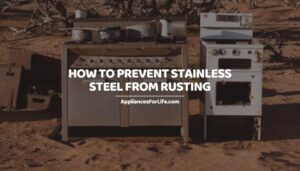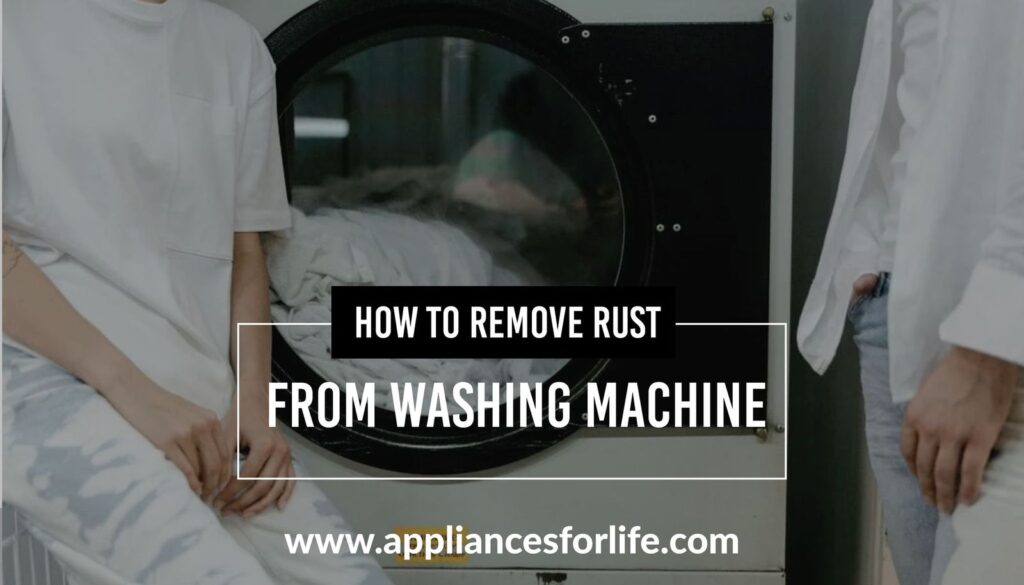- If you’ve ever dealt with rust or corrosion in any of your appliances, you’ll realize how difficult it is to have it in or around your appliances. Knowing how to remove rust from washing machine shouldn’t only be your priority, but also to get familiar with the things that could cause the machine to start showing rustiness. In this article, we’ll be looking at the things that cause a washing machine to rust.
- As much as the washing machine is one of the most popular household appliances in the world today, it’s safe to say that the machine is not susceptible to damage. If your washing machine is beginning to show some rustiness in and around, our detailed guide on how to remove rust from washing machine will help you get your washer back in shape and in the best condition you want.
Cleaning clothes has always been a necessity, although the exercise has been gaining more attention recently due to the growing popularity of washing machines that help make cleaning easier and more convenient. As an adult, one of the most important things to do at home, however hard it can be, is washing clothes. Some, due to not having the washing machine in their homes, often opt for their local laundromat, although that only proves to be more costly at the end of the day, depending on how many times they take their clothes there in a week. At the end of the day, we’ve all realized how important having a washing machine in the house is and how much time it can save us, especially now when every machine is fast and efficient.
Table of Contents
ToggleDoing laundry with hands has supposedly become obsolete and we understand why a lot of folks think that. In the 21st century, every modern household is defined by the tech-inspired appliances in their homes, so doing laundry with hands without the support of any washer seems too traditional to fit into what people believe a modern society should look like. Sadly, as glorified as the washing machine it, it also has its downsides, which will come at you very fast if you don’t maintain the washer properly, and justifiably so.
In a world where many folks are judged by their appearance (who says you shouldn’t judge books by their covers?), having machines that will help make a lasting impression on the people we meet, such as the washing machine that efficiently cleans our clothes, and the pressing iron that makes neatly pressed the clothes. These machines are very necessary for day-to-day life because they make things easier and they bring so much comfort that people are mostly left with no choice but to invest in them as long as they can afford them. Over the years, technology has made appliances the refrigerator, blender, cooking range, and washing machine more appealing to users because manufacturers have tapped into the wealth of advancements to add more user-friendly features to these machines.
We mentioned earlier that even the washing machine, as important as it is, comes with its downside, just like every other appliance available to us today. The thing about these appliances is that they need to be constantly maintained to keep them functioning at the highest level, which is something most folks don’t have time for, even after spending a lot of money on acquiring them. Sometimes, you start noticing rust on your clothes and that shows that the washing machine is beginning to shed rust, probably from the washer tub, which is made of stainless steel and is very susceptible to rust and corrosion.
Let’s say you try to correct the most obvious mistake by rewashing your clothes, with your hands now because you don’t know why your washing machine keeps shedding rust on them. However, if you don’t get to the root of the problem, which is fixing the washing machine itself such that it doesn’t leave rust on your clothes anymore, you’ll only be chasing a dead end. Having rust in your washing machine means that there’s interior damage that needs to be taken care of as soon as possible if you don’t want to spend more money on having a technician come over to fix the problem for you.
According to WD.40, stainless steel washing machines are mostly prone to rust and corrosion, which means that they need some extra maintenance to ensure that rust doesn’t start forming in them as they get older. However, if you ever find rust in washing machine tub or if there’s rust in washing machine drum, you need to know how to remove rust from washing machine, which is what we’ll be discussing in this article. Having rust in your washing machine can be very annoying, but after you solve the big problem of getting rust from your washing machine, you need to look deeply into what might have caused it in the first place, so as to know what to avoid.
Let’s not even talk about the interior now, according to Hunker, most parts of the exterior of any washing machine are made of metal, and, sadly, metal always rusts if it doesn’t get the care it deserves, which is why it’s always very ideal for you to properly maintain your washing machine. Once you begin to notice some rust stains on the inside of your washing machine, your clothes will also start showing rust stains, which means that you need to do something as soon as you can to limit the damage before it completely gets to your clothes. It can also cause you to see rusty water in the washing machine, which makes rust stains on your clothes, but, thankfully, rust stains on the inside are far easier to handle than the ones on the outside.
This was a huge problem for washing machine users many years ago, after which several calls were made, which the manufacturers heard and started making washers with stainless steel tubs that are resistant to corrosion and rust. The washer’s constant exposure to water made the issues of rust and corrosion more difficult to handle many years ago, but this has changed in the past few years. However, that doesn’t mean that washing machines with stainless steel tubs or metal exteriors are still not susceptible to rust and corrosion, especially when metal objects fall around the agitator a lot, which is why you need to know what to and what not to throw in your washing machine.
The problem of many years ago doesn’t exist anymore because most washing machines now have stainless steel in and around them, and since stainless steel is more resistant to corrosion and rust, people don’t quite experience the same problems they experienced many years ago with washing machines. If you don’t pay attention to some details, you’ll be inviting rust and corrosion to your washing machine, which will pretty much reflect on your clothes if you don’t work to fix it as soon as possible. Before we get into how to get rid of rust in washing machine drum, you need to know why a washing machine would rust and the signs you’ll see when this starts happening.
How Do You Know When Your Washing Machine is Rusting?
Washing machine rust repair is absolutely fine, but what’s even more important is paying more attention to the signs of rust in a washing machine before they become unbearable. The mistake most people make is not looking at these signs at all even when they’re there because they would rather think that the signs may mean nothing, or even if they do, you would just not think too much into them. Early detection of rust in your washing machine can save you a lot, so as you begin to notice these signs of rust in your washing machine, it might just be time to investigate and try to get the washer repaired as soon as possible.
Your washing machine is showing strong signs of rust if you begin to notice;
Discoloration of clothing
If you pay attention to details a lot, you should catch some of these signs before they develop into bigger problems for you and your washing machine at the end of the day, which can cause you to spend a lot of money on fixing the problem, or replace the washing machine even. Once you run a load and you notice that the water in the washer is becoming rusty, so much that it starts appearing on your clothes, then you have all the proof you want that there’s rust in your washing machine and it needs to be gotten rid of as soon as possible. The presence of the rust particles in the water will sink deep into fabrics, which can be very hard to get out.
As much as rust stains are difficult to get rid of from clothes, they’re not impossible. You can get most of the rust stains off your clothes by simply trying to dust them off, but this may not help you get rid of these stains completely, which means you have to take more serious measures to get the result you want. One of the serious measures you can take is to add some vinegar or lemon into the water or your load before you start running the washer; just ensure that these elements are safe to be used on the fabrics you’re trying to wash.
Visible rust
The inside of the washing machine (most likely the washing machine tub) is not the only place you can find the signs of rust around your washer. Sometimes, you might just get lucky to notice visible rust around the exterior of the washing machine as well as the inside of the drum, which is enough to indicate that there’s a rust problem with the washing machine that needs to be fixed as soon as possible. If you notice strange colors like brown, orange, red, just a rough and bubbly surface, it is a clear rust sign that needs to be paid attention to.
Whatever form that sign shows up as, it’s something you should try to correct, because, if you leave it, sooner or later, it will start spreading across the washing machine, and will affect your clothes badly. Thankfully, seeing signs means you have enough time to plan ahead and correct whatever might be wrong before the problem becomes bigger and it’s more difficult to solve. What you need to do is find the rust spots (there can be more than one) so you can implement the best corrective measures as soon as possible.
Brown spots
The rust in your washing machine could be coming from the water pipes or the washing machine drum, so you have to pay extra attention to details to see these signs so you can take an action immediately. Once you start noticing red metal-looking chips around the drum, it’s a clear indication that there’s a rust problem, and detecting the problem early enough will help you solve the problem without stress as long as you have the right methods at your disposal.
How To Get Rust out of Washing Machine
The metal in your washing machine ending up rusting is one of the things you should be prepared to face as a washing machine owner because that’s what’s going to end up happening. However, this problem may either be temporary or permanent, depending on how quickly you react and what corrective measures you have at your disposal to best deal with the problem. What you need to know about metal is that it mostly contains iron and, with time, because the washing machine deals with water a lot, rust will begin to form and if you don’t try to take care of the problem, it may damage your washing machine.
Rust can affect your washing machine in two different ways; it can either affect the washer from within which can rub onto your clothing or it can visibly appear on the exterior of your washer which indicates corrosion. At first, your clothes will be the ones feeling most of the impact, but your washing machine’s long-term health and durability will also be put in jeopardy because the rust on the outside can do a lot of damage to the machine before you know it. According to Repair Aid, getting rust stains off the inside of your washing machine is a lot easier than the ones from the outside, but we’ll be exploring both in this article.
Interior Stains
What you’ll need;
- Vinegar or lemon
- Measuring cup
Vinegar and lemon juice have proven to be two of the best ways to deal with rust stains in the washer tub. Thankfully, these are regular elements you can find easily in your kitchen cupboard and they’re perfect for breaking down the compounds responsible for rust in your washing machine. The best way to get rid of rust in your washer tub is to mix 2 cups of lemon juice in a small bowl before putting the mixture into the washing machine and running a cycle. If you’re using white vinegar, you’ll also use 2 cups, only that, this time, you’ll need to let the element rest in the washer for about an hour before running a full cycle.
Exterior Stains
What you’ll need;
- Rust dissolver
- Auto body filler
- Vinegar
- Clean clothes
- Baking soda
- Dry sandpaper
Step 1
Like we said earlier, getting rust off the exterior of your washing machine is more difficult than when you’re getting rid of it on the inside, and that’s why you need to have the right methods. For the first step, you need to spray a solution of vinegar and water onto the affected area of your washing machine, leave the solution to rest on the surface for about 5 minutes, before wiping with a clean cloth. Alternatively, you can also use a mixture of baking soda and water because that also works perfectly for rust.
Step 2
After rubbing the mixture of the washing machine surface, you can now take your 150-grit wet and dry sandpaper to further do justice to the corroded segment of the exterior of the washer. As soon as you can no longer see the effect of the corrosion on the surface, continue to use a rust dissolver to handle the leftovers. Whatever you do, just ensure that you’re following the instructions on the product for some safety and technical reasons.
Step 3
You’ll be surprised that the eroded part of the washer needs to be filled to make it look normal again – at least close to normal. This is where your auto body filler comes in as you’ll mix it with some hardener before applying it smoothly on the affected surface using a plastic putty knife. Try to flatten it with your sandpaper to get a smoother result at the end of the process.
Step 4
Now that you’re done filling the body, it’s time to use the rust-inhibiting primer to prepare the affected areas before you finally coat them with enamel that matches the color of your appliances. Nobody wants to do the job and leave halfway, which is why you need to try to get it across the finish line. You can check your washer’s manufacturer to see if the same enamel can be provided, which will make the whole process perfect.
Frequently Asked Questions
- Is there a rust-proof washing machine?
Most modern washing machines are supposedly rust-proof because they have stainless tubs in them. However, even the stainless steel material is susceptible to stains, including rust and corrosion, so you should be prepared to tackle some, especially when the tubs are taking in a lot of water.
- Why do washing machines rust?
Washing machines are made of metal and have that material all around them, and since metal has iron, you should expect it to rust anytime, which is why you need to be prepared for when that happens.
Conclusion
Believing that your washing machine is immune to rust and corrosion because it’s made of stainless steel might be the worst mistake you’ll ever make as far as maintaining that efficient machine is concerned. Having the best methods to remove rust from your washing machine will come in handy a lot, but what’s more important is being able to catch all the rust signs before the problem destroys your washing machine. In this article, we’ve tried to discuss the signs as well as the right methods to tackle rust in and around your washing machine when it starts appearing.
20 MINUTES
ESTIMATED TIME DESIGNING AND UPLOADING THIS ARTICLE
11 HOURS 34 MINUTES
ESTIMATED TIME RESEARCHING AND WRITING THIS ARTICLE
You Might Also Like

How to Remove Grease from Stainless Steel Appliances?
It is not a surprise that at least one stainless steel appliance or item can now be found in every home; that’s how popular the material is. Demands have skyrocketed over the years and these precious appliances need to be protected at all cost because

How to Remove Rust from Stainless Steel Kettle?
If you own anything made of stainless steel, you’ll always want to make sure the stainless steel doesn’t get destroyed, especially by rust. In this article, we’ll be discussing how rust can destroy your stainless steel and what you can do to get rust out

How to Remove Rust From Washing Machine
If you’ve ever dealt with rust or corrosion in any of your appliances, you’ll realize how difficult it is to have it in or around your appliances. Knowing how to remove rust from washing machine shouldn’t only be your priority, but also to get familiar

How to Prevent Stainless Steel from Rusting?
Stainless steel appliances have become very popular in different households over the years and the need to look after them properly has become very important. In this article, we’re going to be discussing how to prevent stainless steel from rust by looking at some of

How to Remove Rust from Stainless Steel Fridge?
Stainless steel fridge has always proved to be a great option around the home for many reasons. In this article, we’ll be exploring the different ways to remove rust from a stainless steel fridge and leave it with the natural beauty the stainless steel material

